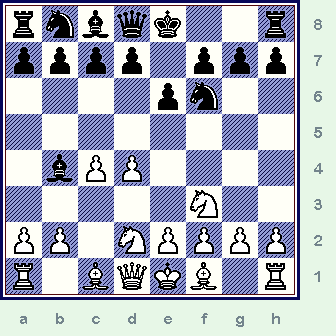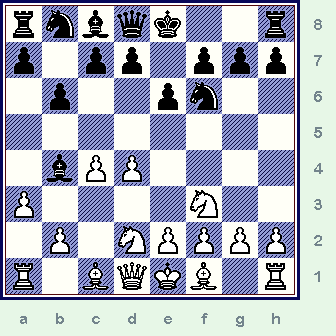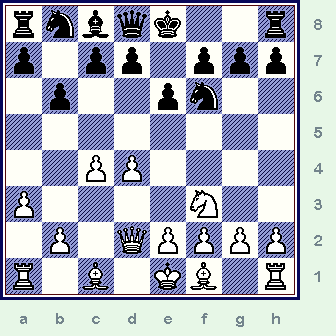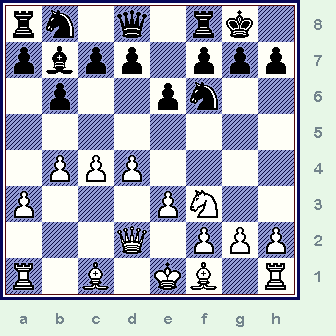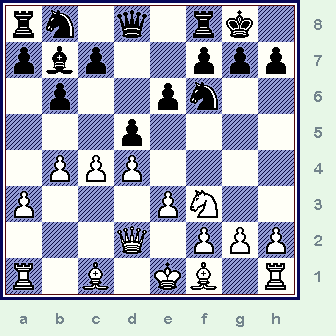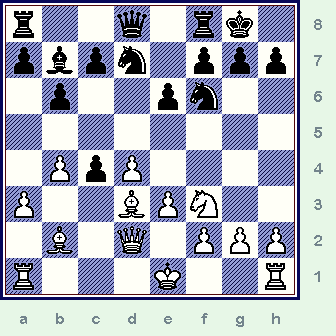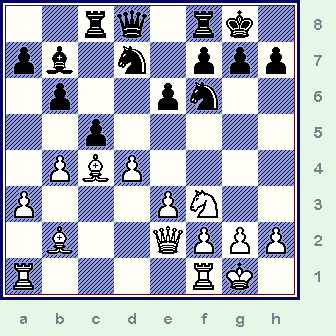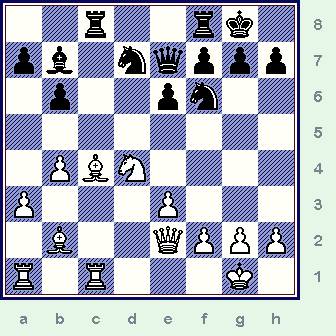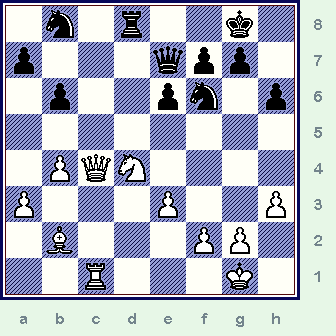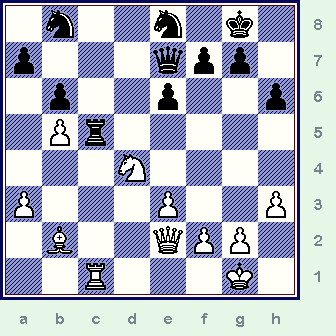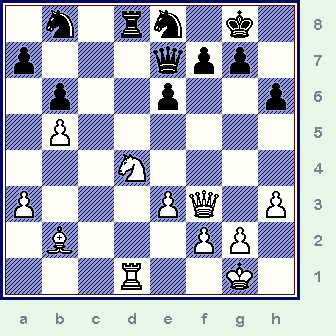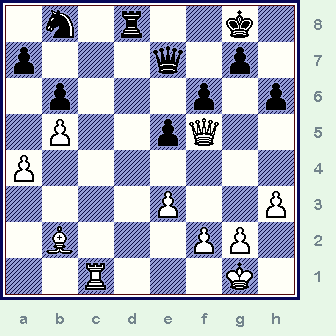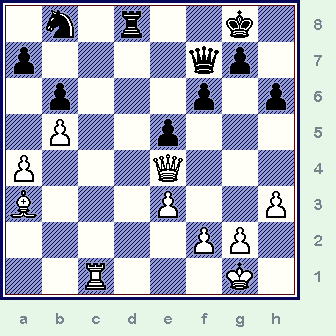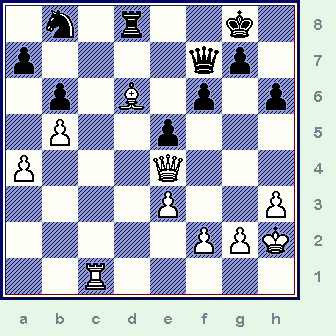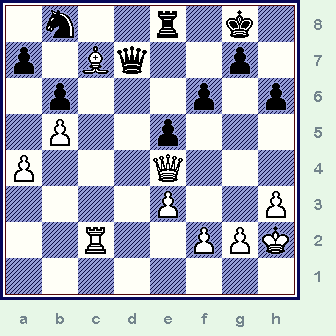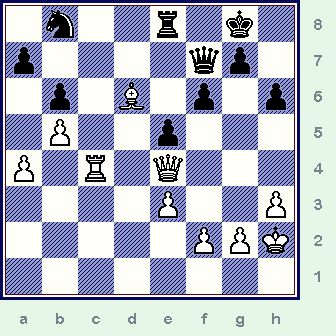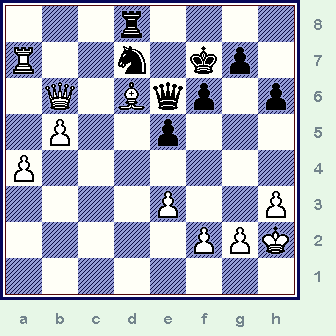All
the |
(Navigation bar
directly below.)
*******
© A.J. Goldsby, 2015.
(All rights reserved.)
****************
Click HERE
to see my
Chess Items.
****************
****************
Buy a book
from Amazon.com
(And help me out as well!)
****************
Click HERE
...
to see a list of the businesses that help to sponsor all of
my chess efforts.
Oh, those dog-gone appellations! |
I don't know how many times I have been led
astray by a "?" or a "?!"
following a move in
a chess book.
(I am sure that GM Andrew Soltis has written on this topic ... at least once in
his popular column, "Chess To Enjoy." See the monthly magazine, "Chess
Life," by the U.S. Chess Federation.)
**************************************************
I will give you a few (personal) examples.
-
Many years ago, I found a nifty little line in a Chess Digest pamphlet on the Grunfeld Defense. White wasn't supposed to be able to give up his Queen, based on a little-known game from the {former} Soviet Union. (In the quoted game, White got ripped to pieces.) What happened the first time I got to play this line in a tournament? My opponent - I think it was in a tournament in Atlanta - took all the material, and then sneered at my attempts to whip up any counterplay.
-
I once played an IM. He played the Najdorf, and then accepted a sacrifice that he was ... {supposedly} ... not able to accept. He even played a move that a book, (published in the 1970's); gave a full question mark ('?') to. He won the game handily, when I questioned him about it after the game, he said, "Oh no. That move is not all that bad." Then he proceeded to show me - all from memory! - the famous game that this analysis was based on ... and where Black really went wrong.
-
Another time, a player, (who was not even a master!); published an article on traps in the old CL&R magazine. I played one of these traps once, believing my opponent to be losing a piece. My opponent in that contest, who was nearly a Senior Master, now proceeded to deliver a forced mate!
So many times you see one of these annotations in a book or magazine, and you will accept them as gospel. They cloud your thinking and obscure good judgment ... and it even suspends good (common) sense! Its happened to me so many times, that I begin not to trust any annotations, published anywhere ... in ANY source!
I was telling this story about a year or two ago at our local chess club, and one player responded that, "Well ... that was way back when. I am sure that never happens in modern times!"
Really?
**************************************************
I offer the game below as a modern case study. White plays a line that many opening books have virulently condemned ... and goes on to win a model game. (Please see the note after White's sixth move.)
Replay this game HERE, (on another website).
Download
an annotated version of this game.
(This is a compressed CB file, that has also been zipped.
If you don't have a ChessBase program,
then get CB Light ...
which should be able to open this download. {Unzip it
first, then open the "star-dot-CBV" file with any ChessBase product.})
See an explanation of the various symbols that I use when annotating a chess game.
GM Lev Aronian (2759) -
GM M. Carlsen (2693)
|
|
|
<< The ding-dong battle between Aronian and Carlsen continued, and it was Aronian's turn to bounce back from his game three defeat and retake the match lead. Carlsen's Bogo-Indian left White with nagging queenside pressure, and the Armenian eventually infiltrated decisively. >> - From the ChessBase website.
***************************************************************************************
1.d4 Nf6; 2.Nf3 e6; 3.c4 Bb4+; 4.Nbd2!?,
{Diagram below.}
One old book that I used to have ...
gave this move a dubious appellation here. (The reasons? It places the QN on a less
than optimum square, blocks in the White QB, and generally mucks up White's whole
Queenside.)
|
|
rnbqk2r/pppp1ppp/4pn2/8/1bPP4/5N2/PP1NPPPP/R1BQKB1R b
However, if it is so bad, why is such a good player as Aronian using it ...
in such an important competition? (To me, it looks like a perfectly normal opening move.)
<<
After the moves of: (3...Bb4+)
4.Bd2 Qe7; we have reached
the opening system known as: "The
Bogo-Indian Defense."
[more,
or here]
[ See
MCO-14, page # 574. ]
( Also playable is the try: 4...a5!?; with complex and interesting play. )
After
the further moves: 5.g3 Nc6; 6.Bg2
Bxd2+; 7.Nbxd2 d6; 8.0-0,
"+/="
8...a5; White has a
slight edge, but Black has a playable game.
What
would be a good example to study? I would have to chose the following
(relatively recent) game:
GM Victor Mikhalevski (2572)
- GM Rogelio Antonio, Jr. (2513);
[E11] / HB
Global Chess Challenge / Minneapolis,
MN; USA / (R#4) / 20,05,2005.
{White won a hard-fought game, 1-0 in
forty-eight (48)
total
moves.} >>
- From my "Game
of The Month" column,
for February, 2006.
[Click
here
... to go there now.]
*******************************************************************************************************************************************************************
[ Today, the
main line is considered to be:
(>/=)
4.Bd2
Qe7; 5.g3, "+/="
when White normally retains a slight pull out of the opening.
A good (again - relatively recent) example of this continuation would be:
GM Artur Jussupow
(2599) - GM Timur Gareev
(2551);
[E11]
ICT,
Aeroflot Open (34 moves)
Moscow, RUS;
(R#2) /
15,02,2007. (34)
{White won a nearly perfect game, 1-0 in thirty-four crisp moves.}
[ See also MCO-14, page #576; columns # 01-06, and also all
applicable notes.
]
***********************************************************************
White generally avoids 4.Nc3,
{D?} in this line.
(Nc3 is a perfectly playable move, however Black
gets a favorable form of the
Nimzo-Indian
{by transposition} ... and this is
why most masters avoid it.) ]
4...b6;
This is the number one choice in the Fritz "Power-Book," it is played twice as much as the flexible 4...0-0. (Which ... BTW ... does nothing about the center.) This move also has the best winning percentages of all the plays in the db, which is probably why it is so popular.
Perhaps - after this contest - Black may want to examine the more energetic move of 4...d5.
5.a3!?, (Maybe - '!')
{Diagram below.}
Again - an older book that I have ...
criticizes this play as possibly premature and perhaps a waste of time as well.
|
|
rnbqk2r/p1pp1ppp/1p2pn2/8/1bPP4/P4N2/1P1NPPPP/R1BQKB1R b
However, as I see it, that's a real important Bishop out there on b4. (Black must now exchange off the cleric, or lose time by retreating it.)
[ White could play almost any move here, like:
5.g3, "+/="
{D?} which also
will yield White a
relatively solid edge out of the opening phase of the game. ]
5...Bxd2+; 6.Qxd2!?, hmmm
{Diagram below.}
White places his Queen on a square where it may be in jeopardy if Black ever plays his Knight to the e4-square.
|
|
rnbqk2r/p1pp1ppp/1p2pn2/8/2PP4/P4N2/1P1QPPPP/R1B1KB1R b
The authors of "Modern Chess Openings," [GM Nick de Firmian and also Walter Korn.]; assign this move a DUBIOUS symbol, ("?!"); ... which usually means that this line is (grossly?!?) INFERIOR to other moves that White might make at this particular point in the chess game. [For the proof, see MCO-14, pg. # 579 and note # (o.) for this line. This is all based on the game, GM Y. Seirawan - GM J. Granda_Zuniga / Amsterdam, NED; 1995.]
[ According to opening theory, it was much better for White to play (instead):
>/=
6.Bxd2 Bb7; 7.Bg5 d6;
8.e3 Nbd7; 9.Qc2 c5; 10.Rd1 Qc7;
11.Be2
0-0; 12.0-0 Rac8;
The end of the column.
13.Bh4
Be4; 14.Qd2 Rfe8; 15.Bg3 e5; 16.dxe5
dxe5; 17.Nh4 h6;
18.f3
Bh7; 19.Bd3 Bxd3; 20.Qxd3 Nf8; 21.Qd6, "+/="
(White has
a small, but solid advantage here.)
GM Vladimir Epishin
(2675) - GM Ulf Andersson
(2620);
Malmö,
Sweden, 1994.
(1-0, 53 moves.)
{White won a solid
effort, which ended with a model R+P endgame.
This game is nicely annotated in the book, The Informant, Volume # 61.}
[ See MCO-14, page # 578; column # 11, and all applicable notes for this
column. Pay special attention to note # (r.) on page # 579 here. ]
]
6...Bb7;
A perfectly normal developing move, and in keeping with the manner that Black has conducted his entire opening.
7.e3,
White prepares to develop his K-side. (He seems to be daring Black to capture on f3, but this would give White 2 Bishops vs. two Knights, and also a half-open g-file ... which would be especially important, if Black castles K-side.)
[ White could avoid getting a set of doubled Pawns by playing
7.Qf4 0-0;
"="
but Black looks OK here. ]
7...0-0; 8.b4!?,
{Diagram below.}
White's plans have been revealed. (He plans to place his QB on the long diagonal. He is not concerned about a possible ...Ne4; as he will just move his Queen, possibly to the c2-square. Meanwhile, he is grabbing some valuable space here on the Q-side.)
|
|
rn1q1rk1/pbpp1ppp/1p2pn2/8/1PPP4/P3PN2/3Q1PPP/R1B1KB1R b
White could have prevented Black from playing ...Ne4; by playing Bd3. (But this did not look like the most efficient way for White to try and finish his development.)
8...d5!?;
{Diagram below.}
Black immediately hits the center, and reinforces his grip on the (key) e4-square ... perhaps with the intent of later landing a Knight on this vital outpost. (In terms of pure application of the opening principles, this would be Black's best move.)
|
|
rn1q1rk1/pbp2ppp/1p2pn2/3p4/1PPP4/P3PN2/3Q1PPP/R1B1KB1R w
This might sound strange, but this could be the place for Black to begin his search for improvements in this tough contest.
[ Maybe this P.O.D. (plan of development) would have been better than the actual game.
Maybe Black
should have tried: 8...d6;
(Hits the center, covers
the e5-square.)
Now Black plays the following moves:
9...Nbd7; 10...Qe7;
11...Ne4; and then
possibly 12...f5. (With a grip on e4.)
See the
contest: A. Stacchini - Y.
Liao; /
The Pan American U-18 Champ.
Mercedes,
1979. (53) {Black won a tough ending, 0-1 in 53 total moves.}
]
9.Bb2 Nbd7; 10.Bd3 dxc4;
{Diagram below.}
The first choice of Fritz ... (and several other
programs). Perhaps
10...c5; would have been a different try for Black?
|
|
r2q1rk1/pbpn1ppp/1p2pn2/8/1PpP4/P2BPN2/1B1Q1PPP/R3K2R w
The idea of this move is that Black frees his QB ... and prepares ...c7-c5; an attempt to simplify and reach an equal position.
11.Bxc4 c5;
This is - seemingly - the correct and indicated Pawn break for Black in this position.
[ Instead, after the continuation: 11...Ne4;
12.Qe2 Ndf6; 13.0-0 Qe7; 14.Ne5, "+/="
when White (also) will have a solid advantage here.
]
12.0-0 Rc8; 13.Qe2!,
{Diagram below.}
White gets off the d-file, avoids any hit to his Queen, (after a later ...Ne4; by Black); and also prepares Ba6. (Which softens up Black on the Q-side by eliminating his main defender of the light squares.)
|
|
2rq1rk1/pb1n1ppp/1p2pn2/2p5/1PBP4/P3PN2/1B2QPPP/R4RK1 b
This would be a good place to stop and study this position carefully.
[ Also, the try of: 13.Rac1, "+/=" would be good for White. ]
13...Qe7; 14.Rfc1 cxd4;
This appears to be the correct capture here for Black.
[ But of course not: </=
14...cxb4?!; 15.axb4 Qxb4??;
16.Ba3, "+/-"
and White wins material. ]
15.Nxd4, "+/="
{Diagram below.}
Take a look at this position.
|
|
2r2rk1/pb1nqppp/1p2pn2/8/1PBN4/P3P3/1B2QPPP/R1R3K1 b
White has more space, two B's, and the slightly freer overall development. Thus - White stands slightly better. (White could have also recaptured on d4 with his Bishop, but the Knight move was probably best, and also the most thematic.)
15...h6?!;
Its too soon for Black to be concerned about back-rank mates.
(Black, who is somewhat cramped, needs to look for healthy, active counterplay from this position.)
The computer's suggestion of 15...a7-a5; looks like Black's best bet here.
* * * * * * * * * * * * * * * * * * * * * * * * * * * * * * * * * * * * * * * * * * * * * * * * * * * * * * * *
Now White exchanges off Black's QB, preparing a slow and steady invasion on the Q-side.
16.Ba6! Bxa6; 17.Qxa6 Rxc1+;
Now this is forced, Black has no good way of holding the c-file.
18.Rxc1 Nb8[]; {'Box.'}
Now Fritz shows that this is forced, otherwise Black will drop his QRP.
[ The alternative was: </=
18...Ra8?;
but after the simple line of
19.Qb7 Qe8;
20.Nc6,
'±' {D?}
Black appears to lose his QRP
without gaining anything concrete
for his loss. ]
19.Qc4 Rd8;
20.h3!,
{Diagram below.}
Now White frees his position from the worry of a back-rank mate.
|
|
1n1r2k1/p3qpp1/1p2pn1p/8/1PQN4/P3P2P/1B3PP1/2R3K1 b
The justification of this move can be found in the following variation: 20.Qc7? QxQ/c7; 21.RxQ/c7, e5!; and if White moves his Knight, he will be mated on his home row.
[ An alternative was: 20.Kf1, "+/=" with some advantage for White. ]
20...Ne8;
This move is designed to prevent the WQ from reaching the seventh rank. Instead, if 20...Nd5; 21.e4, kicks the Knight away and allows White to occupy the 7th rank with his Queen and/or his Rook.
* * * * * * * * * * * * * * * * * * * * * * * * * * * * * * * * * * * * * * * * * * * * * * * * * * * * * * * *
White's following move freezes Black's Knight on the b8-square ...
perhaps for the rest of the game.
21.b5! Rd5;
22.Qe2 Rc5;
{Diagram below.}
Black offers to exchange Rooks.
|
|
1n2n1k1/p3qpp1/1p2p2p/1Pr5/3N4/P3P2P/1B2QPP1/2R3K1 w
Perhaps with the heavy pieces off, Black could try to reach the safety of a drawn game?
23.Rd1!,
(Maybe - '!!')
White avoids the exchange of Rooks and cedes Black the only open file.
(Has White gone nuts?)
The purpose of this strategic retreat will not be revealed until several moves later.
[ White could have also played: 23.Rxc5 Qxc5; 24.Qd3, "+/=" with a clear edge here. ]
23...Rc8; 24.Qf3,
White eyes the c6-outpost, and perhaps dares Black to try and play 24...e5. (The move of 24.e4 also gave White a very solid advantage.)
24...Rd8;
{Diagram below.}
Black voluntarily surrenders the c-file.
|
|
1n1rn1k1/p3qpp1/1p2p2p/1P6/3N4/P3PQ1P/1B3PP1/3R2K1 w
While it is easy to condemn Black's moves, it is very difficult to come up with a constructive plan for Black.
[ Black could have also played:
24...a6!?; 25.a4! a5; 26.Qe4, "+/"
however Fritz assures us that White remains in full control and that
Aronian is clearly better. ]
25.Rc1 Nd6;
Criticized by some pundits on the Internet, but there is no way that Black could have played the rest of the game with his both of his Knights stuck on the first row! (25...Nd6 is also the first choice of Fritz!!)
White's next move tightens his grip on the position and prepares a nasty pin, (after Ba3).
26.a4! e5;
('!?')
This looks like something close to panic, but Black (understandably) did not want to allow White a lot of time to improve his position.
27.Nf5! Nxf5;
28.Qxf5 f6;
{Diagram below.}
Black had to protect the button on e5, and </= 28...Nd7?; allows the monster pin after 29.Rc7.
|
|
1n1r2k1/p3q1p1/1p3p1p/1P2pQ2/P7/4P2P/1B3PP1/2R3K1 w
It has been very instructive to see how White has slowly and patiently increased his advantage with every one of his artful moves.
* * * * * * * * * * * * * * * * * * * * * * * * * * * * * * * * * * * * * * * * * * * * * * * * * * * * * * * *
It is White to move here.
29.Qe4!,
White prevents ...Qb4 by Black while preparing a battery on the c-file with Rc4 and Qc2.
(The try 29.Rc8 was also good for White.)
29...Qf7; 30.Ba3!,
{Diagram below.}
A nice move, Aronian is playing this simplified position in a commendable manner.
|
|
1n1r2k1/p4qp1/1p3p1p/1P2p3/P3Q3/B3P2P/5PP1/2R3K1 b
This Bishop is seemingly striking at empty air, but it cuts through the heart of Black's position and takes away many good squares ... which are no longer available to GM Magnus Carlsen's pieces.
30...Kh8;
Black is running out of ideas. (30...Qd7; was marginally better than this move, yet it would not have freed Black from White's grip on the position.)
Because of the obvious superiority of Black's position, White has the time to make any number of moves to prepare the final blows. (White's next gets the King to safety, and avoids any tactical tricks.)
31.Kh2 Kg8; 32.Bd6!,
{Diagram below.}
This prepares the decisive penetration of White's Rook to the seventh rank.
|
|
1n1r2k1/p4qp1/1p1B1p1p/1P2p3/P3Q3/4P2P/5PPK/2R5 b
In the meantime, Black cannot capture the Rook on the d6-square, as Rc8+ would cost Black his Queen.
32...Qd7; 33.Bc7 Rf8;
It did not matter where Black's Rook went. (After 33...Rc8; then 34.Qb7 is a decisive penetration, and Black will eventually lose both of his Q-side Pawns, just as in the actual game here.)
34.Rc2 Re8;
{Diagram below.}
Because of the poor way that Black handled his game earlier, he is reduced to just shifting wood around.
|
|
1n2r1k1/p1Bq2p1/1p3p1p/1P2p3/P3Q3/4P2P/2R2PPK/8 w
Meanwhile, Aronian is free to wait and watch and figure out exactly how he wants to finish
his opponent off.
[ The computer shows that after:
34...Qd1!?; 35.Bxb8 Rxb8; 36.Rc7, "+/-"
White is already winning. ]
35.Rc4 Qf7; 36.Bd6!,
{Diagram below.}
This prepares the decisive blow of landing the WR on the key c7-square here.
|
|
1n2r1k1/p4qp1/1p1B1p1p/1P2p3/P1R1Q3/4P2P/5PPK/8 b
Take a look at this position, all of White's pieces clearly occupy better squares than their Black counterparts.
[ Another idea would be for White to play: (</=)
36.g4!?, '±'
so as to maintain
the WQ on the important e4-square. ]
36...Rd8?!; (hmmm)
[Maybe just -'?']
A final bobble, Black had to try a desperate attempt for counterplay, perhaps
>/= 36...f5!?
was the way for Carlsen to go.
(
Editor's note: I
have two good reasons for not attaching a full question mark to this
move.
#1.)
Black may already be lost, even with the best defense.
#2.)
Both players were short of time, finding the best move in such situations is always a difficult
proposition. )
The rest needs little comment.
(Black cannot stop the White Rook from coming to the c7-square, and both Black's Queenside
pawns will fall as a result.)
37.Rc7
Nd7[]; (Only move.)
This was forced, 37...Rd7?? is simply and decisively met by
38.Rc8+, winning.
[ </= 37...Qe8?!; 38.Re7 Qf8; 39.Bb4 Kh8; 40.Rxa7, "+/-" ]
38.Qc6 Qe6;
39.Rxa7 Kf7; 40.Qxb6, "+/-" Black Resigns.
{Final diagram below.}
A nearly flawless game by the inscrutable Lev Aronian.
(Where did the young GM Magnus Carlsen go wrong?)
|
|
3r4/R2n1kp1/1Q1Bqp1p/1P2p3/P7/4P2P/5PPK/8 b
I cannot praise Aronian's handling of his forces enough, his play reminds me of the one and only Jose R. Capablanca ... ... ... at his very best.
The entire story for this game ... (and this round of the Candidates matches) ... can be found on the CB website, at http://www.chessbase.com/newsdetail.asp?newsid=3898. (If you scroll down to the end of this article, there is a link to download all of the games in the popular PGN format.)
If you have the "Adobe Reader" program, you can click here, to see the FIDE link and annotations for this game. (You can also save a copy to your computer, if you wish.)
Copyright (c) A.J. Goldsby, 2007. All rights reserved.
1 - 0
This analysis was prepared with the excellent program, ChessBase. (Buy it from the USCF.)
The HTML was polished with several different tools and programs, (mostly FrontPage) ... the text was checked for spelling with MS Word.
The diagrams were created with the program, Chess Captor 2.25.
Click HERE to see my WCA lesson for July, 2006. (Another game in this same opening!)
|
I want to point out that I began my annotations on the same day that this game was played. {And just shortly after the game was completed.} I copied no one else's work. If there is ANY similarity to my annotations and anyone else's ... this is purely a coincidence. [ I also checked my work against dozens of opening books in my library, starting from the most current, and working back to some works that are close to fifty years old. I also checked my analysis with many strong computer programs, to include the following: Fritz 10.0, Junior 10.1, Hiarcs 9, Shredder 9.0, Crafty, (several versions); ChessMaster (10th Edition), Rybka, and a few others as well. ] In addition, I put together a database on the Bogo-Indian ... that only included {quality} games with players rated at least 2300 FIDE ... and then I did dozens of {position} searches inside this db as well. Of course, it took (at least) several days ... to do all this work. (Annotate the game, and then finish this web-page.) |
Click HERE to go (return) to my home page. (For my main GC chess site.)
Click HERE to go (return) to my site map.
Click HERE to go to my domain.
Click HERE to go (return) to the blog pages of Impala Publishing. (This article mentioned there.)
(Or just use the "back button" on your web browser.)
Find ALL of my blog articles on the Impala Publishing website.
*******
Click HERE to see my webpage ... that contains the news and links of the Candidates Matches in Elista, (Kalmykia); in Russia ... for 2007.
*******
This page was created in June 2007, and was first posted on (Friday); June 01st, 2007.
It was last edited on: Sunday, January 06, 2013 , 03:22 AM .
Copyright (©) LM A.J. Goldsby, 2013.
Copyright (c) A.J. Goldsby, 2013. All rights reserved.
